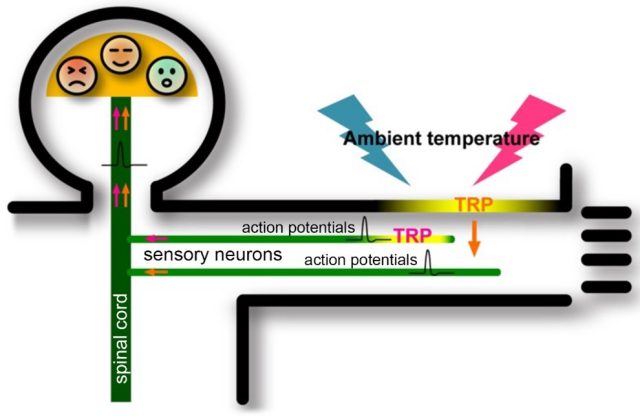Sensory neurons play a crucial role in the perception of “hot” and “cold”. They express a group of ion channels called thermosensitive TRP channels. For example, TRPV1 (activated above 43°C) and TRPM8 (activated below 29°C) send the “hot” and “cold” information to our brains, respectively, for which the 2021 Nobel Prize in Physiology or Medicine was awarded. However, TRPV3, which is activated by warm temperatures (32-39°C), is rarely detected in sensory neurons but is abundantly expressed in the skin keratinocytes. Although the concept that not only sensory neurons but also skin keratinocytes sense temperature has been proposed, there was a big controversy (Figure 1). It is also not concluded whether the response of TRPV3 in epidermal tissue is able to be transmitted to the brain and elicits temperature sensation.
In this study, the research group focused on TMEM79, a protein that is expressed in skin keratinocytes similar to TRPV3 but whose function is not well understood, in order to investigate the function of TRPV3.
First, the research group overexpressed TRPV3 and TMEM79 in HEK293T cells and examined the TRPV3-mediated current responses. As a result, they found that the TRPV3-mediated currents were smaller in the cells co-expressing TMEM79 and TRPV3 than in cells expressing TRPV3 alone. This result indicates that TMEM79 reduces TRPV3-mediated currents.
Then, the research group made TMEM79-deficient mice, and examined the temperature-dependent behaviors using Thermal Gradient Ring with a donut shape. When they made a floor temperature gradient of from 10 to 45°C in the 25°C room temperature condition, wild-type mice preferred about 30.4°C. While TMEM79-deficient mice rapidly moved to warmer temperature of 34.4°C. This result suggests that mouse temperature sensation is affected by the changes in TRPV3-mediated currents in the skin upon loss of TMEM79.
TRPV3-mediated currents were indeed larger in the skin keratinocytes lacking TMEM79 than in those of wild-type mice. This result can be interpreted that TRPV3-mediated currents were inhibited by TMEM79 in the normal condition and that TRPV3-mediated currents were increased without TMEM79.
Finally, the research group examined how co-expression of TRPV3 and TMEM79 causes reduction of TRPV3-mediated currents in the skin keratinocytes. TRPV3 proteins which are normally expressed in the plasma membrane moved to cytosolic space upon co-expression of TMEM79. In another word, reduction of the amount of TRPV3 proteins on the plasma membrane decreased TRPV3-mediated currents. In addition, it was found that TRPV3 proteins were carried to lysosome with TMEM79, followed by TRPV3 degradation, which is consisted with the reduction in the total TRPV3 proteins in the cell upon co-expression of TMEM79. Furthermore, the research group found that TRPV3 makes a physical complex with TMEM79 on the plasma membrane.
Collectively, the research group concluded that temperature sensitivity in the skin is controlled by the regulation of the amount of TRPV3 proteins upon binding with TMEM79 in the skin keratinocytes. These results put an end to the long-standing controversy regarding the possible involvement of skin keratinocytes in temperature detection (Figure 1). It is expected that this could lead to the development of the way for controlling our temperature sensation by regulating the function of TRPV3 or TMEM79.
###
Title: Involvement of skin TRPV3 in temperature detection regulated by TMEM79 in mice
Author: Jing Lei, Reiko U. Yoshimoto, Takeshi Matsui, Masayuki Amagai, Mizuho A. Kido, Makoto Tominaga.
Journal: Nature Communications
DOI: https://doi.org/10.1038/s41467-023-39712-x
Summary
We sense the environmental temperature with our sensory neurons, and this information is conveyed to the brain, resulting in our temperature sensations of hot, cold, and warm. However, there has been disagreement as to whether the skin also senses temperature. In this study, a research group has revealed that TRPV3 ion channels in skin keratinocytes could sense warm temperature and lead to temperature-dependent behaviors. This work put an end to the long-standing controversy. The study was published in Nature Communications.
 Figure 1.
Figure 1.
There are two kinds of detection of ambient temperature in the periphery, through sensory neurons and through skin keratinocytes. In the latter case, the temperature information should be transferred to the sensory neurons. Thermosensitive TRP channels are involved in both cases.
Contact
Media contact :
Strategic Research Administration Office
Exploratory Research Center on Life and Living Systems (ExCELLS)
National Institutes of Natural Sciences
E-Mail: press_at_excells.orion.ac.jp
(Please replace the “_at_” with @)
Expert contacts :
TOMINAGA, Makoto
Exploratory Research Center on Life and Living Systems (ExCELLS)
National Institute for Physiological Sciences (NIPS)
Natural Institutes of Natural Sciences, Okazaki

